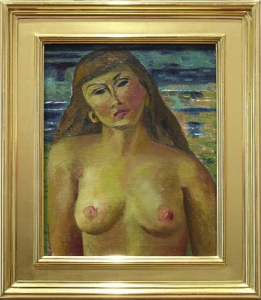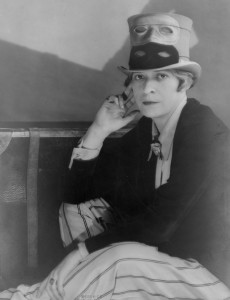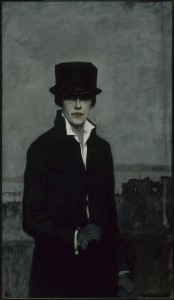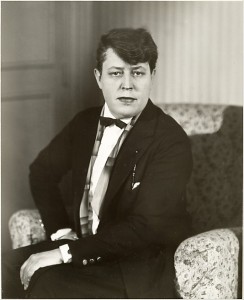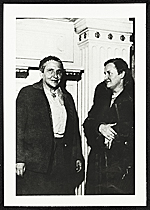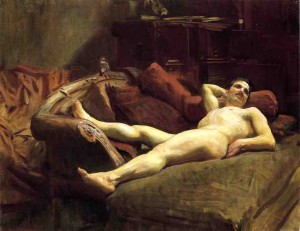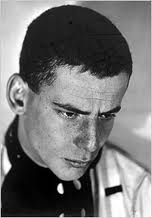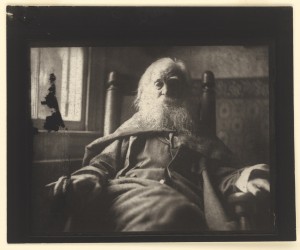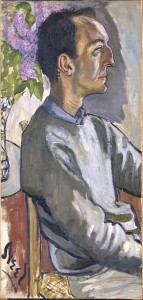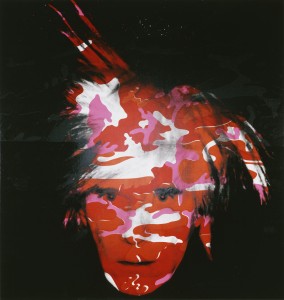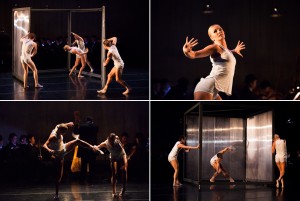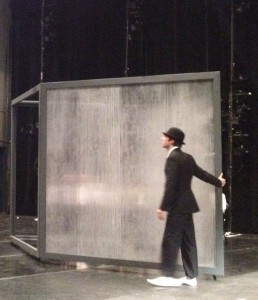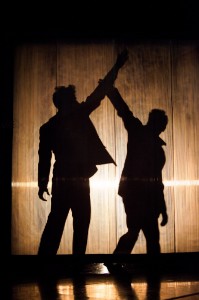“Hide/Seek” and “Approaching Ecstasy”
At the beginning of the exhibition Hide/Seek, Difference and Desire in American Portraiture, which I saw at the Tacoma Art Museum(it is up until June 10) we are immediately captured by a painting of a nude woman from the waist up, her full breasts swelling and her nipples hard, in deep shades of pink. The woman’s face suggests some detachment, but her physicality almost jumps out of the frame.
Astonishingly, this is an early work by Agnes Martin, an artist who became famous for paintings of abstract lines and colors so subtle that you could barely see them. She tried to destory all of her early works. This nude’s assertiveness declares desire (perhaps thwarted). It offers an explanation for the deeply withdrawn mature works. No matter how many elegies are written to those horizontal penciled lines on a beige surface, they remain, for me, an absolute rejection of physicality, of the world, of love. Martin lived as a recluse. She developed her minimalist abstractions in New York City in the early 1960s, a time dominated by aggressive men and continued them, after a hiatus of a few years, for the rest of her life.
The examples from the late nineteenth and early twentieth century in Hide/Seek, Difference and Desire in American Portraiture, particularly fascinated me. In those years being homosexual was dangerous and illegal ( as witnessed in the famous case of Oscar Wilde), except among the wealthy in Paris. Berenice Abbott photographed some of the famous women of that time, like Janet Flanner and Djuna Barnes. These photographs are old friends. We feel that we are sitting in the room with these women. But we also know that they all made crucial contributions to culture as journalists, poets, writers, visual artists. Abbott’s photographs approaches them as individuals who are entirely comfortable with themselves.They were first immortalized as a group by Sheri Binstock’s wonderful book Women of the Left Bank.
The austere self portrait of Romaine Brooks is still the defining lesbian image of that Paris era. We know of so many extraordinary women who are not included in Hide/Seek who can be encompassed by this amazingly androgenous, male identified black suited, white shirted top hatted Brooks.
I am thinking particularly of Jane Heap about whom I have written two articles as the extraordinary editor of the Little Review in the 1920s. She was photographed by Berenice Abbott in a tuxedo and bow tie. Her absolutely engaged penetrating look as well as her swaggering posture, suggests her defiance, her status as a person who, according to her magazine’s slogan, “made no compromise with the public taste.” At this time, she had already published the first chapters of James Joyce’s Ulysses in her magazine and been sued for libel. in the United States. She was, in 1922, being taken up by the Paris avant-garde as a hero.
Abbott went back to NYC and in the middle of the 1930s she fell in love with Elizabeth McCausland, the extraordinary art critic and another subject of one of my articles. Here you see her as an adoring young writer, on the right , with Gertrude Stein in 1934, following the presentation of Stein’s Four Saints in Three Acts in Hartford, Connecticut. As I discuss in my article and my book on the 1930s, McCausland wrote eloquently and passionately about Four Saints, focusing mainly on the score by Stein, in one of her newspaper columns for the Springfield Republican.
Both McCausland and Abbott joined the political left in NYC, as defined a society as Paris of the Left Bank, only in the 1930s sexual identity was superceded by fighting fascism, the Popular Front, and the American Artists Congress, as I discuss in detail in my book, Art and Politics in the 1930s.
But to return to the artists of Hide/Seek, John Singer Sargent’s 1895 painting of his male servant relaxing nude on a sofa is one of many that we have never seen, no matter how familiar we are with Sargent’s sumptuous watercolors and seductive society portraits.
Likewise Grant Wood’s Arnold Comes of Age of 1930 tells us about Wood beyond American Gothic, at the same that it sheds light on that so familiar work.
Lincoln Kirstein in Dorm at Harvard by Walker Evans reminds us that most of the prominent artists and curators of that era were friends at Harvard (Alfred Barr was there too, just a little earlier) and many of them closeted. Kirstein was to be so profoundly important in twentieth century culture in the world of dance, that we treasure looking at the intelligent and concentrated young man in this photograph and knowing his future.
The theme of Hide/Seek is “How Gender and Sexual Identity Have Shaped Modern American Portraiture.” It was curated by Jonathan D. Katz and David C. Ward with the purpose of “tracing the evolution of sexual identities.” The scope of the exhibition is actually greater than that. Most of the people who created the images and most of the people represented in the art are all extraordinarily important to American cultural life in the last 120 years.
For example, there is Thomas Eakins’ stunning photograph of an aging Walt Whitman, from 1891, an iconic image, of one great artist by another.
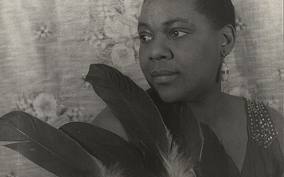 Of the same marriage of artist and subject, is Carl Van Vechten’s photograph of Bessie Smith. the great blues singer. Vechten captures Bessie, not as the confident performer, but as a woman sadly gazing at her demons.
Of the same marriage of artist and subject, is Carl Van Vechten’s photograph of Bessie Smith. the great blues singer. Vechten captures Bessie, not as the confident performer, but as a woman sadly gazing at her demons.
Alice Neel’s portrait of Frank O’Hara, the great poet and art critic, in profile, suggests his central place in New York City’s cultural life of the mid century.
These artists admired one another for their brilliant creativity. In some cases they shared a common community, in others, they created their own entourage, as with the well- known example of Andy Warhol represented in Hide/Seek, by a stunning camouflage self portrait in brilliant shades of red and magenta, that calls attention to Warhol as one of the first absolutely uncamouflaged gay artists, as well as one of the most closeted people in terms of his art and its intentions. This flame- like headdress seems to underscore that contradiction. He looks down, escaping our direct gaze, unlike the riveting defiant expression of, for example, Jane Heap.
The exhibition continues through to the present, with the shattering outbreak of AIDS in the late 1980s and through the 1990s, that tragic watershed in American cultural life and activism. The current century is only briefly represented. With good reason: as in the 1930s, the centrality of identity is again being eclipsed by pressing political concerns and gay rights seems to have become primarily a national focus on marriage.
But these artists and their subjects, were often not about sexual identity either, with some exceptions like the wonderful Tee Corinne, whose work I was so glad to see included here. Tee reveled, like Jane Heap, in defying norms, and explicitly representing exactly what she wanted to in her drawings. 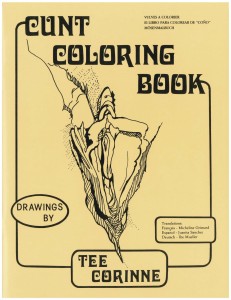
These artists are all about creativity, at a time when that frequently meant marginalization. Many radical artists, writers, musicians, playwrights, and dancers were and are gay. Being gay gives an intense understanding of what injustice feels like (still). They extend that awareness into many directions.
Part II Approaching Ecstasy
That is the case with the phenomenal Approaching Ecstasy, a dance collaboration composed by Eric Banks and choreographed by Olivier Wevers based on the poetry of Constantine P. Cavafy, a Greek who lived most of his life as both a bureaucrat and a closeted homosexual in Cairo in the early 20th century.
Approaching Ecstasy premiered at the Intiman THeater in Seattle in May 2012. Hopefully, it will be performed again and again.
The musicians and singers wore black suits with bowler hats a la Rene Magritte, while the dancers of the group Whim W’him, escaped in various ways from the closet, both literally and figuratively (the only set was a folding metal frame that could be 2 or 3 dimensional, a mirror, a room, a building, a closet, or a wall.
As the 40 members of the Esoterics, accompanied by St Helens String Quartet, plus a harp, sang the lush sexually specific poetry of Cafavy in both Greek and English, we were transported to a place of liberation, of extraordinary multimedia poetry in sound and movement.
Emerging out of darkness into light was also a crucial aspect of the staging designed by Jeff Forbes. The collaboration was much more than the sum of its parts, just as the portraits of Hide/Seek are more than the sum of their identities. I was fortunate to see these two expressions of creativity in one day.
One poem by Cafavy (translated by Eric Banks)
Senses (1912)
Return to me often and take me,/O senses that I love, return and take me: /Then my body will awaken, /And the cravings I once felt will flow in my blood again; /Then my lips and my skin will remember,/ And my hands will understand how to touch once more. /Return to me often and take me, in the night, /Then my lips and my skin will remember.
Cafavy is best known for his poem “Waiting for the Barbarians” which never seems to stop being an insightful commentary on contemporary politicians. But knowing this poem so well, as well as so many of his other poems, made the exclusive emphasis on his sensual love poetry all the more compelling. As with the case of the John Singer Sargent and Grant Wood paintings in Hide/Seek, bringing together the man in more than the sum of the parts that we know enriches our appreciation of what creativity means and expands our understaning of their humanity.
Waiting for the Barbarians” by Constantine Cafavy
“What are we waiting for, assembled in the forum?/The barbarians are due here today./Why isn’t anything happening in the senate?/Why do the senators sit there without legislating?/Because the barbarians are coming today./What laws can the senators make now?/Once the barbarians are here, they’ll do the legislating./Why did our emperor get up so early,/and why is he sitting at the city’s main gate/on his throne, in state, wearing the crown?/Because the barbarians are coming today/and the emperor is waiting to receive their leader./He has even prepared a scroll to give him,/replete with titles, with imposing names/.Why have our two consuls and praetors come out today/wearing their embroidered, their scarlet togas?/Why have they put on bracelets with so many amethysts,/and rings sparkling with magnificent emeralds?/Why are they carrying elegant canes/beautifully worked in silver and gold?/Because the barbarians are coming today/and things like that dazzle the barbarians/.Why don’t our distinguished orators come forward as usual/to make their speeches, say what they have to say?/Because the barbarians are coming today/and they’re bored by rhetoric and public speaking./Why this sudden restlessness, this confusion?/(How serious people’s faces have become.)/Why are the streets and squares emptying so rapidly, /everyone going home so lost in thought?/Because night has fallen and the barbarians have not come./And some who have just returned from the border say/there are no barbarians any longer./And now, what’s going to happen to us without barbarians?/They were, those people, a kind of solution.”
This entry was posted on May 31, 2012 and is filed under Art and Politics Now.

